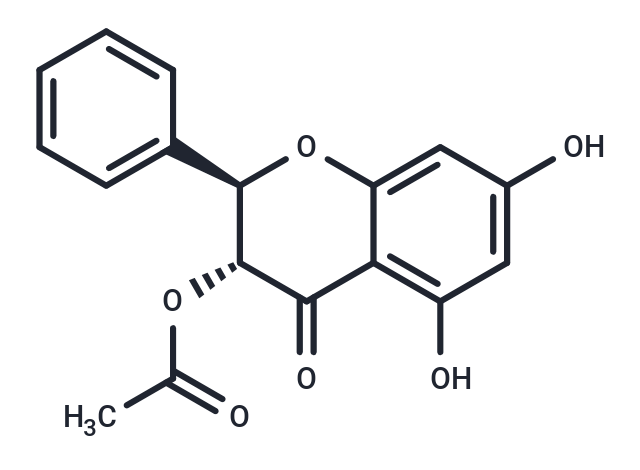Shopping Cart
- Remove All
 Your shopping cart is currently empty
Your shopping cart is currently empty

Pinobanksin 3-acetate (3-O-Acetylpinobanksin), a flavonoid derivative, is a strong antioxidant found in sunflowers and honey that inhibits LDL peroxidation.

| Pack Size | Price | Availability | Quantity |
|---|---|---|---|
| 1 mg | $72 | In Stock | |
| 5 mg | $233 | In Stock | |
| 10 mg | $347 | In Stock |
| Description | Pinobanksin 3-acetate (3-O-Acetylpinobanksin), a flavonoid derivative, is a strong antioxidant found in sunflowers and honey that inhibits LDL peroxidation. |
| Targets&IC50 | PANC1 cells:17.9 μM, PANC1 cells:9.1 μM |
| In vitro | Two new phenylallylflavanones, (2R,3R)-6-[1-(4'-hydroxy-3'-methoxyphenyl)prop-2-en-1-yl]pinobanksin (1) and (2R,3R)-6-[1-(4'-hydroxy-3'-methoxyphenyl)prop-2-en-1-yl]Pinobanksin 3-acetate (2) were isolated from a methanolic extract of Mexican propolis. Both compounds (1, 2) exhibited preferential cytotoxic activity against PANC-1 human pancreatic cancer cells in a nutrient-deprived medium with the concentration at which 50% of cells died preferentially in NDM (PC₅₀) values of 17.9 μM and 9.1 μM, respectively.[1] |
| Alias | 3-O-Acetylpinobanksin |
| Molecular Weight | 314.29 |
| Formula | C17H14O6 |
| Cas No. | 52117-69-8 |
| Smiles | CC(=O)O[C@@H]1[C@H](Oc2cc(O)cc(O)c2C1=O)c1ccccc1 |
| Relative Density. | 1.46g/cm3 |
| Storage | store at low temperature,keep away from direct sunlight | Powder: -20°C for 3 years | In solvent: -80°C for 1 year | Shipping with blue ice. | |||||||||||||||||||||||||||||||||||
| Solubility Information | DMSO: 90.0 mg/mL (286.4 mM), Sonication is recommended. | |||||||||||||||||||||||||||||||||||
Solution Preparation Table | ||||||||||||||||||||||||||||||||||||
DMSO
| ||||||||||||||||||||||||||||||||||||

Copyright © 2015-2025 TargetMol Chemicals Inc. All Rights Reserved.